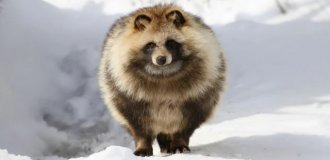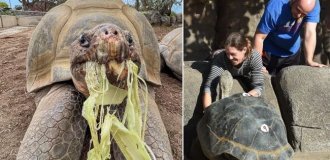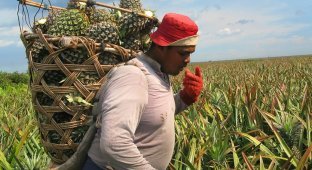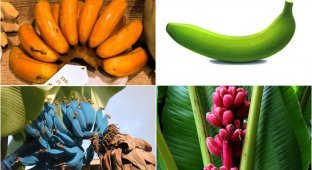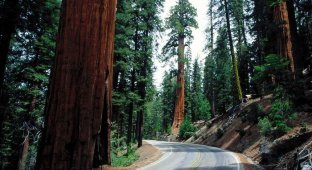We recently had a post about pineapples and how and where they grow. Today I propose to learn about bananas.

Since childhood, we are accustomed to thinking that bananas grow on palm trees. But it turns out that banana is a herb. Of course, not the kind that grows on lawns, but a giant one, reaching a height of 5-6 to 15 m.
Grass, that is! It is difficult for a resident of central Russia, accustomed to bending over to look for strawberries and lingonberries in the forest, to imagine a banana grass three to four meters high, on the stem of which hang three hundred “berries” weighing half a centner. In addition, the diameter of the “grass” is a good ten centimeters. At the top it ends in a spreading panicle of oblong leaves (which is why the European reaction is unambiguous: palm tree). Something like a one and a half meter long trunk hangs from a rosette of leaves from top to bottom.
Bananas don’t even have a trunk (like trees) - they don’t even have a normal stem. Its stem is more like a tuber and is almost invisible above the ground. But there are huge leaves - fans, up to 6 m long and up to a meter wide.

250-300 small bananas are tied to the inflorescence. The trunk is correctly called a “bunch,” and what we buy and call clusters are actually clusters of four to seven fused fruits. A real banana bunch is a lot of bunches, closely adjacent to each other. Bananas have been known to mankind since ancient times.

Their homeland is called the tropical and subtropical regions of Asia, mainly India and China. At least in these countries, bananas have long been considered sacred fruits that restore strength and nourish the mind. Some Indian pagodas that have survived from those times have roofs that exactly follow the shape of a banana: this is how it was respected. From India and China, banana culture spread to Asia Minor.

Later they began to be grown on the east and west coasts of Africa. In the 16th century, they were brought to the Canary Islands, Central and South America. The countries there are the last to have banana plantations in the world, and they are the best at growing and selling them: Ecuador, Colombia, Panama supply the whole of Europe with bananas. If before we ate - it’s clear why - exclusively Cuban varieties, now we are also full-fledged Europeans: most of all Ecuadorian fruits are on our market.

A few words about how bananas are harvested. As soon as the ovaries on the bunch begin to form, a plastic cover is urgently pulled over it so that, God forbid, nothing gets on the ripening fruits. So they grow under hoods, protected from tropical insect pests, for eleven weeks. They don’t reach full ripeness, but they should be taken to another continent!
At this stage the harvest time comes. Nothing has changed over the centuries: the same way our great-grandfathers and grandfathers collected the harvest is the same way they do it now. A worker, holding a long pole with a powerful cleaver screwed to the end, approaches the trunk and, deftly baling it high, cuts off a huge bunch. And how it will rustle down... (I see that our people, who give the weekend to six hundred square meters, have already shuddered: if an apple or a pear falls, it’s a pity that it will remain! And here fifty kilograms of banana tenderness crash to the ground?!)

So they were scared in vain - centuries-old experience teaches: there is no better landing place for the bunch than the shoulders and back of the second worker, specially standing nearby. Having cheerfully depreciated, he drags the harvest to the warehouse on himself. There, the bunches will be disassembled into small parts, thrown into tanks with a special liquid for greater disinfection and long-term preservation, and then caught, dried, wrapped in plastic, packed in branded boxes, and they will travel by sea, rarely by plane, to other countries. And the “trunk” from which the bunch was cut is no longer alive. Dries up.

Grass is grass. But from the rhizome, new “blades of grass” are already climbing out of the ground into the light of God. True, they take a whole year to grow to maturity. And they will also bring only one bunch each, but the process of renewal on the plantations is continuous. How continuous the harvest is in a warm climate: some bunches are cut, others are ripening, others are setting... In a word, long live the eternal tropical summer! And may bananas not disappear on our table!

At night, banana flowers are visited by bats, and during the day they are visited by numerous insects, sunbirds and squirrel-like animals - tupayas, which are distant relatives of monkeys. Bananas generously treat all visitors with nectar. After pollination, the covering leaves fall off and fruits begin to set in place of the flowers. There are so many lateral inflorescences on one peduncle that when the last covering leaves begin to open at its end, the fruits at the base are already ripe.
The yellow, crescent-shaped fruit of the banana bears little resemblance to a berry*, but from a botanist's point of view, a banana is a berry with a leathery shell and sweet pulp, in which numerous seeds are embedded (if you cut a banana, you can see small black dots inside).

It must be said that not all types of bananas have the same fruits that we can buy in our markets and stores. Some fruits are shorter, some are oval or almost round, some are longer and thinner. When ripe, the peel sometimes turns red rather than yellow. But such bananas are not delivered to us - they do not tolerate transportation well.
After fruiting, the entire huge above-ground part of the plant dies off, but from the base of the false stem, underground shoots have already begun to grow, which will give rise to new false stems. This is how bananas reproduce vegetatively.

Green bananas have the consistency of potatoes, but they taste very astringent and resinous—completely inedible. Bananas are harvested by completely cutting down a thick grassy trunk, with one blow of a sickle - the second time the same shoot (what is incorrectly called a palm tree in Russia) does not bear fruit. Then the bunch is cut off from the trunk and left to ripen. A few days after harvesting, green bananas ripen and become our usual yellow. The sale of green bananas is widespread.

The banana came to us from Malaysia, where it has been grown for 10 thousand years. Wild bananas, which can still be found in Southeast Asia, contain large, hard seeds and very little pulp. They are pollinated by bats.
Your supermarket banana is a cultivar chosen by planters for its fleshy flesh and lack of seeds. Cultivation produced a plant that is sweet, tasty, but sterile: such a banana is not able to reproduce without human help.

Most banana plants have not had “sex” for 10 thousand years. Almost every banana that we eat with such pleasure is propagated by hand: from the shoot of an already existing plant, whose genetic fund has not been updated for 100 centuries. As a result, bananas are extremely susceptible to various types of diseases. Many of its species have already fallen victim to fungal infections such as “black sigatoka” and “Panama disease”, which are very resistant to fungicides. And if a genetically modified variety is not developed soon, we may forget about bananas forever.

The problem, by the way, is very serious. Bananas are the world's most profitable export crop. The industry is worth $12 billion a year and supports 400 million people, many of whom live below the poverty line.
Most bananas come from hot countries, but, paradoxically, Iceland is Europe's largest banana producer. Bananas are grown in spacious greenhouses heated by geothermal waters, just two degrees south of the Arctic Circle.
Fyffe's, a multinational importing company that purchases the entire banana harvest from Belize each year, is Irish-owned.

With the same weight, dried bananas contain 5 times more calories than fresh ones.
India produces more bananas than any other country in the world.
Sprinter Linford Christie, an Olympic gold medalist, includes fried plantain in his diet before competitions or training.
In East Africa, bananas are fermented and beer is made from them.

Banana fruits are consumed raw, fried, or boiled. Bananas are used to prepare soups, baked goods, desserts, and main courses. But special varieties of bananas are fried and boiled. The bananas we eat were developed by crossing different types of bananas.
Bananas are not only eaten as food. Banana peels are used to make black dye; leaves are used for baking, instead of foil and baking paper; light buildings and rafts are made from stems; The leaves are used to make packaging.
Bananas are also widely used in medicine. The fruits help in the fight against high blood pressure, anemia, heartburn, and depression. Banana flowers are used to treat stomach ulcers, dysentery, bronchitis, and diabetes. They are brewed and drunk like tea. Burns are perfectly healed by young banana leaves, like our plantain.









